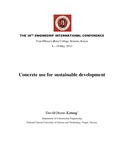| dc.contributor.author | Koteng, David Otieno | |
| dc.date.accessioned | 2014-02-24T06:30:42Z | |
| dc.date.available | 2014-02-24T06:30:42Z | |
| dc.date.issued | 2013-05 | |
| dc.identifier.citation | Koteng, David Otieno. "Concrete use for sustainable development,2013." | en_US |
| dc.identifier.uri | http://hdl.handle.net/11295/64825 | |
| dc.description | THE 20TH ENGINEERS’ INTERNATIONAL CONFERENCE Tom Mboya Labour College, Kisumu, Kenya 8 – 10 May, 2013 | en_US |
| dc.description.abstract | Concrete is a primary construction material of the modern age with over 13 billion metric tons being used globally every year. It is a man-made material with a great impact on the economy and the environment. Its properties largely depend on the raw materials used, the skills of the concrete mix designer, and how the concrete is placed and finished. Issues of concern are strength, durability, ease of placement, economy and impact on the environment. Experiences have shown that improperly designed or constructed concrete is prone to sulfate attack (SA), acid attack (AA), efflorescence, alkali-aggregate reaction (AAR) and rebar corrosion (RC). Early degradation results in high maintenance or replacement costs which divert scarce resources from the primary objective of expansion of infrastructure. Environmental issues of concern are high energy and raw material consumption, and high CO2 emission in cement production. This paper reviews the use of concrete in Kenya and offers suggestions for sustainable use of concrete for national development. | en_US |
| dc.language.iso | en | en_US |
| dc.subject | sustainability | en_US |
| dc.subject | high performance | en_US |
| dc.subject | green concrete | en_US |
| dc.title | Concrete use for sustainable development | en_US |
| dc.type | Working Paper | en_US |

